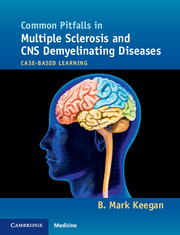Book contents
- Common Pitfalls in Multiple Sclerosis and CNS Demyelinating DiseasesCase-Based Learning
- Common Pitfalls in Multiple Sclerosis and CNS Demyelinating Diseases
- Copyright page
- Contents
- Preface
- Chapter 1 Pitfalls in identifying the classical clinical features of MS
- Chapter 2 Pitfalls in correctly assessing the clinical course of MS
- Chapter 3 Pitfalls in recognizing uncommon MS clinical presentations
- Chapter 4 Challenges in the therapeutic management of MS
- Chapter 5 Challenges in diagnosing demyelinating ocular disease
- Chapter 6 Pitfalls in diagnosing cerebral parenchymal disease
- Chapter 7 Pitfalls in diagnosing demyelinating cerebellar disease
- Chapter 8 Challenges in diagnosing demyelinating brainstem disease
- Chapter 9 Challenges in diagnosing spinal cord disease
- Index
- References
Chapter 6 - Pitfalls in diagnosing cerebral parenchymal disease
Published online by Cambridge University Press: 05 May 2016
- Common Pitfalls in Multiple Sclerosis and CNS Demyelinating DiseasesCase-Based Learning
- Common Pitfalls in Multiple Sclerosis and CNS Demyelinating Diseases
- Copyright page
- Contents
- Preface
- Chapter 1 Pitfalls in identifying the classical clinical features of MS
- Chapter 2 Pitfalls in correctly assessing the clinical course of MS
- Chapter 3 Pitfalls in recognizing uncommon MS clinical presentations
- Chapter 4 Challenges in the therapeutic management of MS
- Chapter 5 Challenges in diagnosing demyelinating ocular disease
- Chapter 6 Pitfalls in diagnosing cerebral parenchymal disease
- Chapter 7 Pitfalls in diagnosing demyelinating cerebellar disease
- Chapter 8 Challenges in diagnosing demyelinating brainstem disease
- Chapter 9 Challenges in diagnosing spinal cord disease
- Index
- References
- Type
- Chapter
- Information
- Common Pitfalls in Multiple Sclerosis and CNS Demyelinating DiseasesCase-Based Learning, pp. 50 - 63Publisher: Cambridge University PressPrint publication year: 2016



